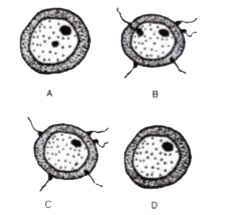How do gametogenesis and fertilisation playan important role in maintaining constancy in chromosome number during sexual reproduction?
Step-by-Step Text Solution:
1. Understanding Chromosome Number:
- In sexual reproduction, organisms typically have a diploid (2N) chromosome number. For example, in humans, the diploid number is 46 chromosomes.
2. Gametogenesis:
- Gametogenesis is the process of forming gametes (sperm and egg cells). This occurs through meiosis, a type of cell division that reduces the chromosome number by half.
- During meiosis, a diploid cell (2N) undergoes two rounds of division to produce four haploid (N) gametes, each containing half the number of chromosomes. In humans, this results in gametes with 23 chromosomes.
3. Fertilization:
- Fertilization is the fusion of male and female gametes. When a sperm (N) fertilizes an egg (N), the two haploid sets of chromosomes combine.
- This fusion restores the diploid condition (2N), resulting in a zygote that has the original chromosome number. In humans, the zygote will again have 46 chromosomes (23 from the sperm + 23 from the egg).
4. Maintaining Chromosome Number:
- Through gametogenesis and fertilization, the chromosome number remains constant across generations. The reduction in chromosome number during gametogenesis is balanced by the restoration during fertilization.
- Thus, even though the gametes are haploid, the resulting zygote is diploid, maintaining the species' chromosome number.
5. Conclusion:
- Gametogenesis and fertilization are crucial processes in sexual reproduction that ensure the constancy of chromosome number. They allow for genetic diversity while preserving the integrity of the chromosome count in the organism.
- In sexual reproduction, organisms typically have a diploid (2N) chromosome number. For example, in humans, the diploid number is 46 chromosomes.
- Gametogenesis is the process of forming gametes (sperm and egg cells). This occurs through meiosis, a type of cell division that reduces the chromosome number by half.
- During meiosis, a diploid cell (2N) undergoes two rounds of division to produce four haploid (N) gametes, each containing half the number of chromosomes. In humans, this results in gametes with 23 chromosomes.
- Fertilization is the fusion of male and female gametes. When a sperm (N) fertilizes an egg (N), the two haploid sets of chromosomes combine.
- This fusion restores the diploid condition (2N), resulting in a zygote that has the original chromosome number. In humans, the zygote will again have 46 chromosomes (23 from the sperm + 23 from the egg).
- Through gametogenesis and fertilization, the chromosome number remains constant across generations. The reduction in chromosome number during gametogenesis is balanced by the restoration during fertilization.
- Thus, even though the gametes are haploid, the resulting zygote is diploid, maintaining the species' chromosome number.
- Gametogenesis and fertilization are crucial processes in sexual reproduction that ensure the constancy of chromosome number. They allow for genetic diversity while preserving the integrity of the chromosome count in the organism.
Topper's Solved these Questions
- REPRODUCTION IN ORGANISMSBook:ICSEChapter:REPRODUCTION IN ORGANISMSExercise:PRACTICE QUESTIONS (D)( Long Answer Type Questions) (5 Marks each)
Explore 5 Videos
- REPRODUCTION IN ORGANISMSBook:ICSEChapter:REPRODUCTION IN ORGANISMSExercise:PREVIOUS YEAR.S BOARD PAPER QUESTIONS (A) ( Very Short Answer Type Questions) (1 mark each)
Explore 9 Videos
- REPRODUCTION IN ORGANISMSBook:ICSEChapter:REPRODUCTION IN ORGANISMSExercise:PRACTICE QUESTIONS (B)( Short Answer Type Questions) (2 Marks each)
Explore 17 Videos
- QUESTION PAPER 2022 TERM 1Book:ICSEChapter:QUESTION PAPER 2022 TERM 1Exercise:MULTIPLE CHOICE QUESTIONS
Explore 45 Videos
- REPRODUCTIVE HEALTHBook:ICSEChapter:REPRODUCTIVE HEALTHExercise:SOURCE BASED QUESTIONS
Explore 23 Videos
Similar Questions
Significance of meiosis in
(a) Reduction of chromosome number to one half
(b) Maintaining constancy of chromosome number during sexual reproduction
(c) Production of genetic variability
(d) All of above
View SolutionHow is the chromosome number maintained in sexually reproducing organisms?
View Solution
Knowledge Check
A few statements with regard to sexual reprodction are given below.
(i) Sexual reproduction does not always require two individuals.
(ii) Sexual reproduction generally involves gametic fusion.
(iii) Meiosis never occurs during sexual reproduction.
(iv) External fertilisation is a rule during sexual reproduction.
Choose the correct statements from the option below.A(i) and (iv)B(i) and (ii)C(ii) and (iii)D(i) and (iv)
How do methanogenes play important role in biogas production.
View SolutionGiven below are diagrams showing the different stages in the process of fertilisation of an egg in the human female reproductive tract.
Study the diagrams and answer the questions

(i) Arrange the letters given below each diagram in a logical sequence to show the correct order in the process of fertilisation.
(ii) Where does fertilisation normally take place? What is 'Implantation' that follows fertilisation ?
(iii) Mention the chromosome number of the egg and zygote in humans.
(iv) Explain the term 'Gestation'. How long does Gestation last in humans ?
(v) Draw a neat, labelled diagram of a mature human sperm.
View SolutionA few statements with regard to sexual reprodction are given below.
(i) Sexual reproduction does not always require two individuals.
(ii) Sexual reproduction generally involves gametic fusion.
(iii) Meiosis never occurs during sexual reproduction.
(iv) External fertilisation is a rule during sexual reproduction.
Choose the correct statements from the option below.
View SolutionA few statements with regard to sexual reprodction are given below.
(i) Sexual reproduction does not always require two individuals.
(ii) Sexual reproduction generally involves gametic fusion.
(iii) Meiosis never occurs during sexual reproduction.
(iv) External fertilisation is a rule during sexual reproduction.
Choose the correct statements from the option below.
View SolutionConstancy of the chromosome number in sexually produring generation is brought by the process of
View SolutionIs the chromosome number of zygote, embryonal cells and adult of a particular organism always constant? How is the constancy maintained in these three stages?
View SolutionAssertion :- Calyx and corolla are accessory whorls of the flower.
Reason :- They do not have direct role in sexual reproduction.
View Solution